In the realm of professional communication, crafting the perfect subject line for a meeting request is paramount. The subject line is the first impression your email makes, determining whether it gets opened and how promptly the recipient responds. As a seasoned marketer, I have seen how a well-crafted subject line can significantly enhance the effectiveness of meeting requests, fostering stronger professional relationships and driving business success.
This comprehensive guide explores the art of creating compelling subject lines for meeting requests, integrating hidden gem strategies that may not be widely recognized but can substantially improve your email engagement rates. Additionally, we will delve into how Prism Reach, an innovative AI-powered SaaS solution, can complement these strategies by enhancing email personalization, optimization, and analytics.
At a Glance
- Understanding the importance of subject lines in meeting requests.
- Integrating hidden gem strategies to optimize subject lines.
- Leveraging Prism Reach for personalized and data-driven email campaigns.
- Best practices for crafting engaging subject lines.
- Utilizing analytics and automation to continuously improve email performance. “Email has an ability many channels don’t: creating valuable, personal touches – at scale.” — David Newman
Key Facts About Subject Lines for Meeting Requests
- The subject line is the primary factor influencing email open rates.
- Clear and specific subject lines convey professionalism and purpose.
- Personalization increases the likelihood of positive responses.
- Including a sense of urgency can prompt quicker replies.
- Analyzing past email performance is essential for optimizing subject lines.
Upgrade Your Email Marketing with AI Personalization!
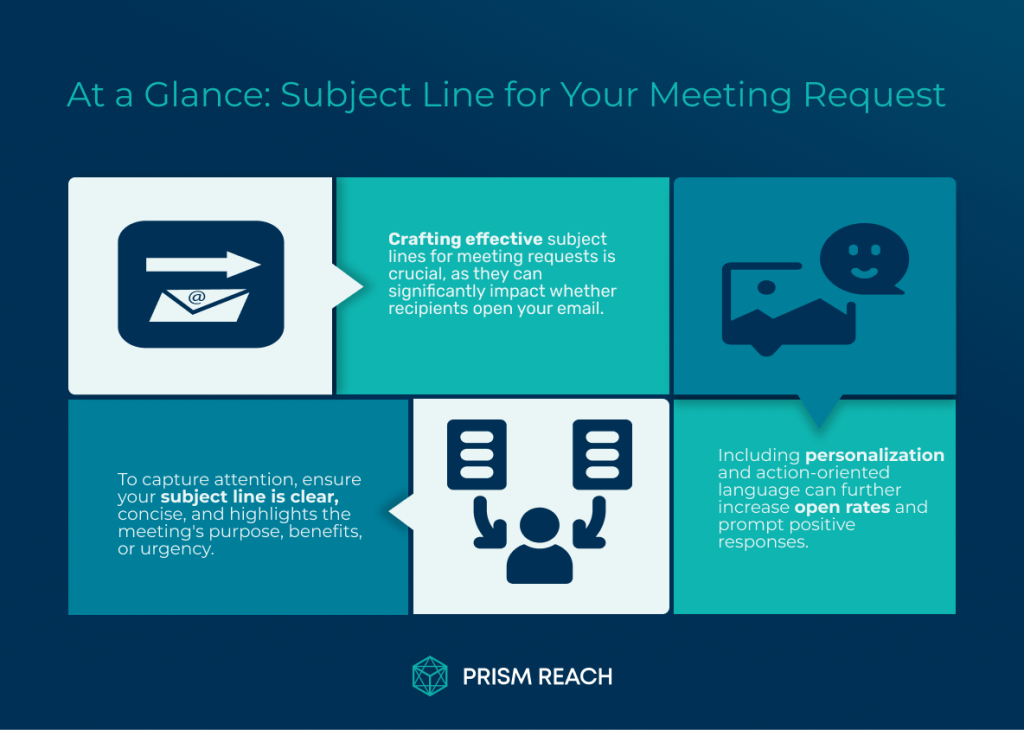
Hidden Gem Strategies for Crafting Effective Subject Lines
While the fundamental principles of email marketing are widely recognized, several lesser-known strategies can significantly enhance the effectiveness of your meeting request subject lines. Here are five “hidden gem” strategies that can transform your email marketing efforts:
1. Highlight Mutual Connections
If applicable, mention mutual connections in the subject line to build rapport. For example, “Meeting Request from [Mutual Connection’s Name]” can increase the likelihood of a response.
- Potential Effectiveness: High
- Level of Obscurity: High
- Ease of Implementation: Easy
- Uniqueness: High
Leveraging mutual connections adds a layer of trust and familiarity, making your request more compelling. Prism Reach can automate the inclusion of mutual connections by integrating with your CRM, ensuring personalized and relevant subject lines.
2. Utilize Personalization Techniques
Including the recipient’s name or company in the subject line can make it feel more personalized and relevant, such as “Meeting Request to Discuss Opportunities with [Recipient’s Company].”
- Potential Effectiveness: High
- Level of Obscurity: Low
- Ease of Implementation: Easy
- Uniqueness: Moderate
Personalization not only increases open rates but also demonstrates that you value the recipient’s time and attention. Prism Reach’s AI-driven personalization ensures each subject line is tailored to the individual subscriber, enhancing engagement.
3. Incorporate Numbers or Lists
Using numbers can increase engagement. For example, “3 Key Points to Discuss in Our Meeting” sets clear expectations and draws attention.
- Potential Effectiveness: Moderate
- Level of Obscurity: Moderate
- Ease of Implementation: Easy
- Uniqueness: Moderate
Numbers provide clarity and structure, making the subject line more digestible and enticing. Prism Reach can analyze which types of numerical subject lines perform best with your audience, allowing for data-driven optimization.
4. Frame as a Question
Subject lines framed as questions can pique curiosity and encourage opens. For example, “Can We Discuss the New Project Timeline?” invites engagement.
- Potential Effectiveness: High
- Level of Obscurity: Moderate
- Ease of Implementation: Easy
- Uniqueness: High
Questions engage the recipient’s curiosity and prompt them to seek answers by opening the email. Prism Reach’s AI can suggest question-based subject lines that align with your audience’s interests and behaviors.
5. Utilize Advanced Scheduling Tools
Leverage email marketing platforms with advanced scheduling features that allow you to optimize send times based on recipient behavior patterns automatically.
- Potential Effectiveness: High
- Level of Obscurity: Low
- Ease of Implementation: Easy
- Uniqueness: Low
Optimizing send times ensures your meeting request emails are delivered when recipients are most likely to read them. Prism Reach’s AI-powered scheduling tools predict the best times to send emails to each subscriber, enhancing open rates and responses.
Best Practices for Crafting Effective Subject Lines
Crafting effective subject lines involves a combination of creativity, strategy, and leveraging the right tools. Here are some best practices to follow:
1. Be Direct and Specific
- Clearly state the purpose of the meeting.
- Avoid vague or generic subject lines like “Meeting Request” or “Quick Chat.”
- Provide enough detail to inform the recipient of the meeting’s relevance.
Being direct and specific helps the recipient quickly understand the purpose of the meeting and decide whether it’s relevant to them. Prism Reach can assist in generating specific subject lines based on meeting topics and goals.
2. Personalize Your Approach
- Include the recipient’s name or company to make the email feel more personal.
- Reference previous interactions or shared connections.
- Tailor the subject line to the recipient’s interests or role.
Personalization fosters a stronger connection with the recipient, increasing the likelihood of a positive response. Prism Reach’s AI-driven personalization ensures each subject line is uniquely tailored to the individual recipient.
3. Highlight the Benefit or Value
- Emphasize what the recipient stands to gain from the meeting.
- Showcase how the meeting can solve a problem or achieve a goal.
- Make the value proposition clear and compelling.
Highlighting the benefit or value of the meeting gives the recipient a compelling reason to attend. Prism Reach can analyze subscriber data to identify what benefits resonate most, allowing you to craft subject lines that speak directly to your audience’s needs.
4. Create a Sense of Urgency
- Use phrases like “Urgent,” “Time-Sensitive,” or “Quick” to convey urgency.
- Encourage prompt responses by emphasizing the importance of the meeting.
- Avoid overusing urgency to maintain trust and credibility.
Creating a sense of urgency can prompt quicker responses and prioritize your meeting request. Prism Reach’s AI can help determine the optimal level of urgency based on past engagement metrics.
5. Ask a Question
- Pose a question that engages the recipient’s curiosity.
- Encourage the recipient to seek answers by opening the email.
- Ensure the question is relevant and meaningful to the recipient.
Questions in subject lines can pique curiosity and encourage recipients to open the email to find out more. Prism Reach’s AI can suggest relevant questions that align with your meeting’s purpose and the recipient’s interests.
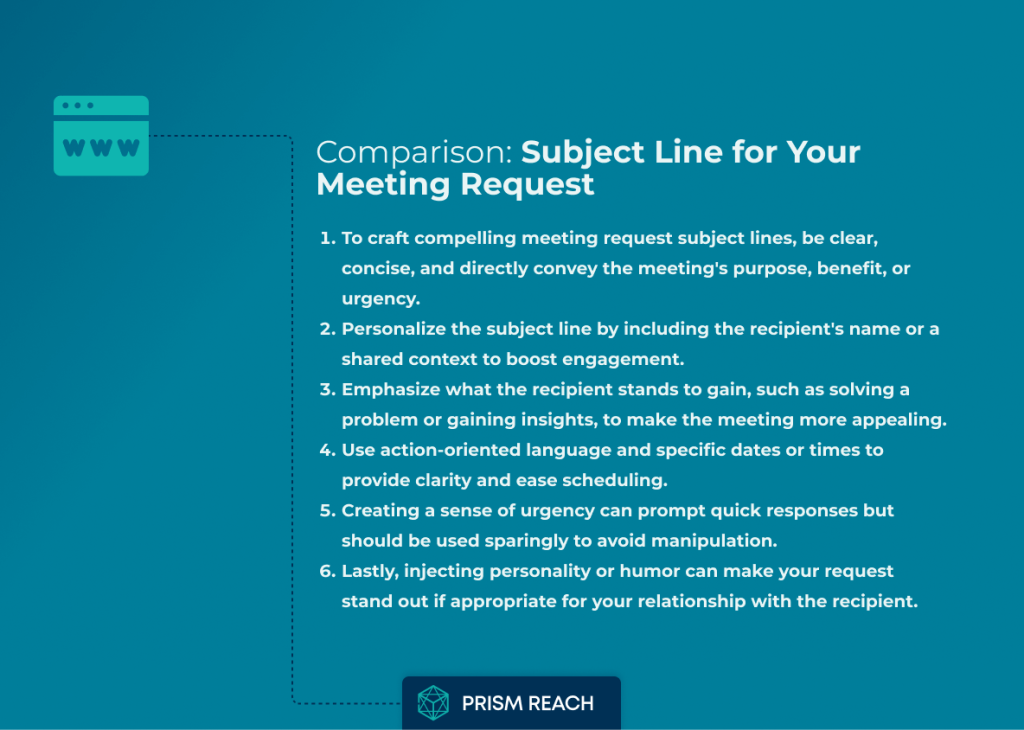
Enhancing Your Email Marketing with Prism Reach
While mastering the art of crafting effective subject lines is essential, leveraging advanced tools like Prism Reach can elevate your email marketing efforts to new heights. Prism Reach is an innovative AI-powered SaaS solution designed to enhance the effectiveness of email marketing campaigns through deep personalization, advanced analytics, and automated scheduling.
Key Benefits of Prism Reach
- Enhanced Personalization: Prism Reach uses sophisticated AI algorithms to customize every aspect of your email campaigns based on subscriber behavior and preferences, resulting in more engaging and relevant communications.
- Advanced Analytics: Gain deep insights into your email performance with comprehensive analytics, helping you understand what works and where improvements are needed.
- Automated Scheduling: Optimize send times automatically based on predictive analytics, ensuring your emails are delivered when subscribers are most likely to engage.
Prism Reach’s Advanced Features
Prism Reach offers a suite of features designed to streamline and enhance your email marketing efforts:
- AI-Powered Personalization: Clusters content into relevant categories and creates detailed user avatars for highly personalized email content.
- Seamless Setup and Integration: Quick integration within minutes with one-click uploads for existing subscriber lists.
- Dynamic Content Selection: AI determines the most relevant content for each recipient, ensuring your emails are tailored and engaging.
- Automated Proofreading: Identifies and corrects spelling, grammar, and punctuation errors to maintain professionalism.
- Tone Analysis: Assesses the tone of your emails and provides suggestions to ensure your message is clear and respectful.
- Comprehensive Analytics: Tracks email performance metrics, offering insights into open rates, click-through rates, and overall engagement.
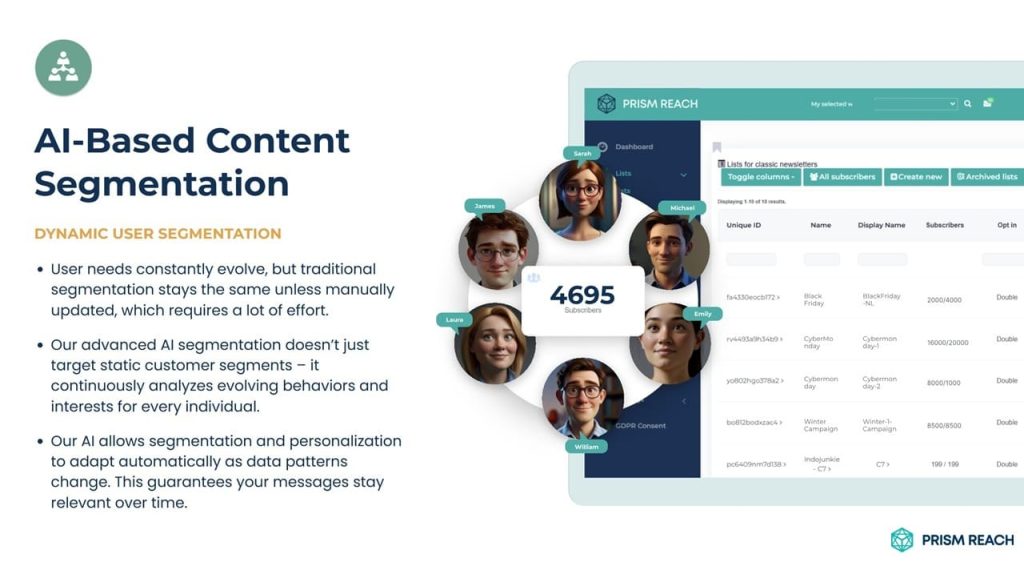
Streamlined User Journey with Prism Reach
The typical user journey with Prism Reach involves a streamlined process where you set up your account, import your contact list, and begin crafting personalized email campaigns with the help of AI-driven tools. Subscribers receive tailored messages that resonate with their preferences and behaviors, enhancing their experience and increasing the likelihood of positive interactions.
Compliance and Data Privacy
Prism Reach places a strong emphasis on GDPR compliance and hosts data within secure, European servers, adhering to the highest standards of data protection. This focus on privacy is crucial for building trust with your recipients and ensuring that your email communications comply with international regulations.
Future Prospects
Looking ahead, Prism Reach aims to expand its capabilities by integrating more advanced AI features and expanding into new sectors such as eCommerce. The company is committed to continuous improvement, ensuring that its solutions remain at the forefront of email marketing technology and innovation.

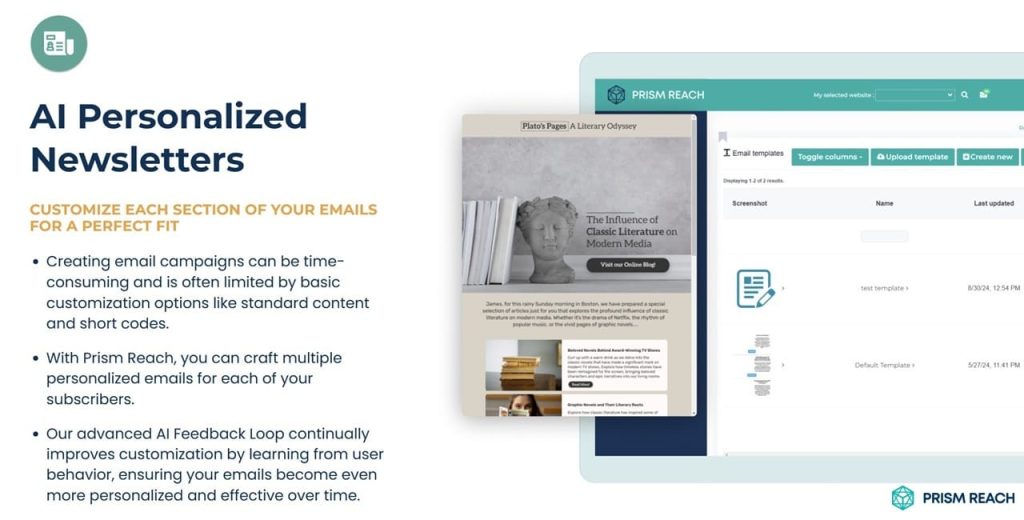
Maximizing Email Marketing Effectiveness with Prism Reach
Email marketing remains one of the most effective channels for nurturing leads, driving conversions, and fostering long-lasting customer relationships. Prism Reach can help you craft compelling email campaigns that resonate with your subscribers, ensuring higher engagement and click-through rates.
Prism Reach Integration Benefits
Integrating Prism Reach into your email marketing strategy offers several benefits:
- Personalized Engagement: Tailor email content to individual subscriber preferences, enhancing relevance and interaction.
- Automated Optimization: Utilize AI to automatically adjust send times and content for optimal performance across devices.
- Data-Driven Insights: Leverage comprehensive analytics to understand email effectiveness and refine your strategies accordingly.
By harnessing these benefits, Prism Reach ensures that your email campaigns are not only visually appealing but also strategically effective in driving engagement and conversions.
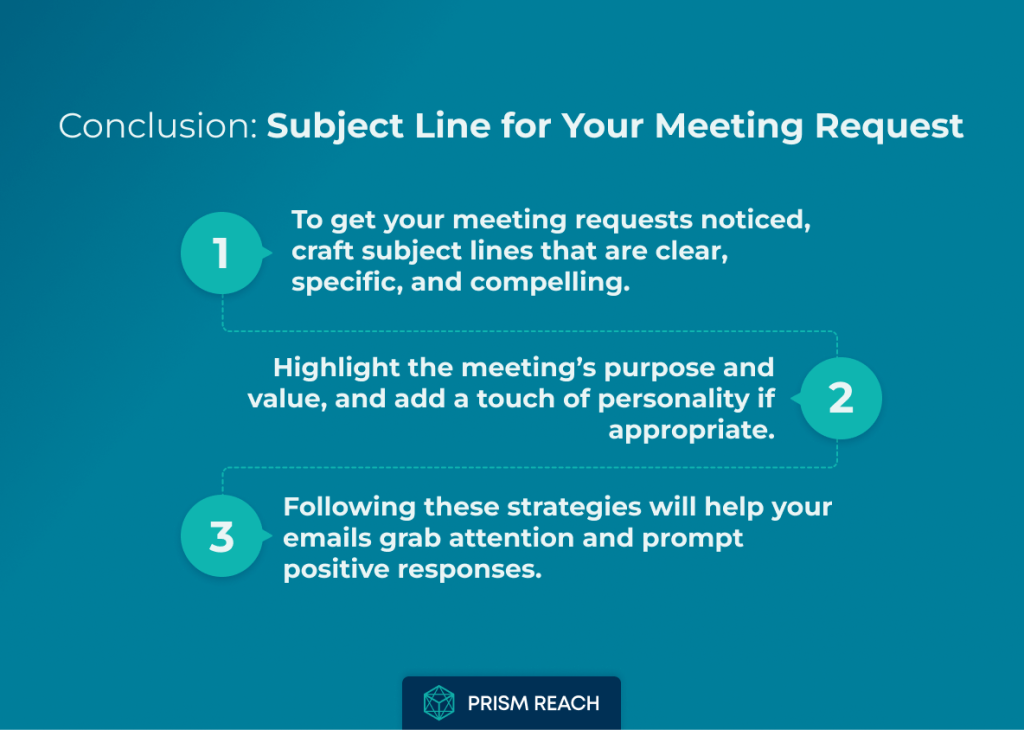
Conclusion
Crafting an effective subject line is a critical step in getting your meeting request noticed and accepted. By following the strategies outlined in this article and studying the examples provided, you’ll be well on your way to writing subject lines that grab attention and elicit positive responses.
Remember, the key is to be clear, specific, and compelling. Highlight the purpose and value of the meeting, and don’t be afraid to inject some personality when appropriate.
Furthermore, leveraging tools like Prism Reach can elevate your email marketing efforts. With its AI-driven personalization, advanced analytics, and automated scheduling features, Prism Reach simplifies the process of delivering the right message to the right audience at the right time. This not only boosts engagement and open rates but also drives higher conversions and revenue.
Embrace the power of effective subject lines and AI-powered tools to unlock the full potential of your email marketing strategy. Start crafting subject lines that truly resonate with your audience and secure those important meetings today.
“On average, 8 out of 10 people will read your headline copy, but only 2 out of 10 will read the rest.” – Brian Clark